Anuradha Maurya1*, KT Chandrashekar1, Rohit Mishra1, Elashri Chatterjee1, Anushree Choudhary1, Anurag Maurya1
1Department of Periodontics, Hitkarini Dental College and Hospital, Jabalpur, Madhya Pradesh, India
*Corresponding Author: Anuradha Maurya, Department of Periodontics, Hitkarini Dental College and Hospital, Jabalpur, Madhya Pradesh, India; Email: [email protected]
Published Date: 06-08-2022
Copyright© 2022 by Maurya A, et al. All rights reserved. This is an open access article distributed under the terms of the Creative Commons Attribution License, which permits unrestricted use, distribution, and reproduction in any medium, provided the original author and source are credited.
Abstract
The periodontal regeneration is one of the main objective in periodontal management and can be achieved by use of barrier membrane, bone grafts and growth factors. Calcium sulphate, an alloplast material and platelet rich fibrin was used in this clinical trial.
Aims: To compare medical grade calcium sulphate hemihydrate with and without platelet rich fibrin as a bone regenerative material in the treatment of intraosseous periodontal defects by clinical and CBCT assessment.
Materials and Methods: 30 defect sites were included in the study and were randomly allocated to either Group A, Group B or Group C. Group A was the control group, Group B included the placement of medical grade calcium sulphate hemihydrate whereas Group C included the placement of medical grade calcium sulphate hemihydrate with platelet rich fibrin in periodontal intrabony defects. Statistical analysis of plaque index, gingival index, probing pocket depth, clinical attachment loss and defect fill by CBCT was performed.
Statistical analysis used: Kruskal Walis test and Chi‑square test for categorical variables were used for analysis. The critical levels of significance of the results were considered at 0.05 levels, i.e., P < 0.05 was considered statistically significant.
Results: Statistically more significant difference in probing pocket depth, clinical attachment loss and defect fill was observed in Group C (MGCSH+PRF) in comparison to Group B (Medical Grade Calcium Sulphate Hemihydrate) which showed better results than Group A.
Conclusion: MGCSH with PRF produced more favourable results than MGCSH alone.
Keywords
Medical Grade Calcium Sulphate Hemihydrate; Platelet Rich Fibrin; Periodontal Regeneration
Introduction
The aim of periodontal therapy involves, maintaining the health of periodontium by elimination of etiological factors, arrest the disease progression, prevent the destruction of bone and regenerate the lost structures due to periodontal disease [1]. The periodontal regeneration can be accomplished by using barrier membrane, bone grafts and growth factors [2]. Different alloplastic materials are used in intraosseous defects which acts as a framework for new bone formation to occur. Alloplastic grafts have the potential to get replaced by newly forming bone and strengthens the host bone matrix. The alloplastic graft contains components similar to bone (e.g. calcium and phosphate) which promotes bone regeneration also they have the property of biological stability and volume maintenance which helps in cell infiltration and remodelling [2]. The field of bone tissue engineering have seen tremendous growth over the years, since the mid 1980’s. The engineered bone tissue is a potential substitute for conventional use of bone grafts due to their abundant supply and no disease transmission [3]. Dreesmann in19th century has used slurry of plaster added with 5% of phenol to treat bone defects in humans [4]. Calcium sulphate was first used in dentistry by Bahn in 1966 [5]. The extensive work of Peltier on Calcium sulfate led to the development of a medical grade alpha Calcium sulfate hemihydrate cylindrical pellet for the treatment of bony defects [4]. Calcium sulfate has many characteristics of an ideal bone graft for regeneration as it is an osteoconductive, osteoinductive and osteogenic material. It can be obtained from natural sources as well as synthetic sources. The chemical structure of calcium sulfate has three forms first is anhydrous calcium sulfate, which is available in two forms insoluble and soluble anhydrite, second is calcium sulfate hemihydrate and third is the calcium sulfate dihydrate. Calcium sulfate hemihydrate has two forms alpha and beta which have similar chemical properties [3]. Calcium sulphate is replaced by the newly formed bone within the first three weeks and undergoes complete resorption by five to seven weeks by dissolution and calcifies gradually by 12th week [6]. Histomorphometric study in humans was conducted by Ahmad Kutkut, et al., using the medical grade calcium sulphate hemihydrate along with platelet rich plasma for extraction socket preservation before the placement of implant which showed greater vital bone formation at 3 months [7]. Toloue SM, et al., (2012) has compared calcium sulphate with freeze dried bone allograft for preserving the dimensions of the alveolar ridge after the extraction and found calcium sulphate is equally effective as a freeze dried bone allograft [8]. Platelet Rich Fibrin is a second generation platelet concentrate prepared from non anti coagulated blood by centrifugation which forms fibrin matrix that contains platelets, leukocytes, cytokines, structural glycoprotein and growth factors (TGF, PDGF, VEGF) and glycoproteins which accelerates wound healing and helps in periodontal regeneration [9]. PRF also contains thrombin which helps in polymerization of fibrinogen into fibrin which plays crucial role in wound healing. PRF also increases the production of osteoprotegerin which causes proliferation of osteoblasts and act as osteoconductive and osteoinductive material which initiates bone regeneration [9]. Sharma, et al., studied the effect of PRF on 3 wall intrabony defect and reported significant improvement in pocket depth reduction and bone fill [10]. Cheah, et al., in 2014 used platelet rich plasma and calcium sulphate hemihydrate for ridge preservation and histomorphometric analysis revealed increased new bone formation in tested sites [11]. Hence, considering the good regenerative potential, the present clinical study was conducted to evaluate medical grade calcium sulphate hemihydrate with and without platelet rich fibrin as a bone regenerative material in the treatment of intraosseous periodontal defects by clinical and CBCT assessment.
Material and Methods
The sites were randomly assigned to each group and this randomized control trial was carried out to measure the effectiveness of the treatment, in the Department of Periodontics and Implantology, Hitkarini Dental College and Hospital Jabalpur (M.P.). A sample size of 10 intraosseous periodontal defect sites in each group were included in the study.
Inclusion Criteria: Patients between the age group 30-60 years, who were diagnosed with chronic generalized periodontitis periodontal pockets of ≥ 5 mm with radiographic evidence of vertical bone loss without any history of systemic disease were included in this study [13].
Exclusion Criteria: Patients showing unacceptable oral hygiene during pre-surgical (Phase I) period, smokers and pregnant women were excluded [13].
Study Design: Ethical clearance was obtained from the ethical committee and written informed consent form explaining the nature of the study and surgical procedure were signed by each patient. Before surgical intervention, each patient received phase I therapy for eradicating the etiological factors such as plaque and calculus and were subjected to the assessment of plaque index (Silness and Loe, 1964), gingival index (Loe and Silness, 1963), probing pocket depth (using UNC-15 probe, clinical attachment loss and Cone Beam Computed Tomography assessment.
Preparation of medical grade calcium sulphate hemihydrate: Medical grade calcium sulphate hemihydrate was prepared by Pansilam’Impact (Jabalpur) by the autoclave method which consist of heating of the calcium sulphate bihydrate in an autoclave to temperature above 100℃ and stored in a sterile container (Fig. 1-11) [1].
Preparation of platelet rich fibrin: The required quantity of blood is taken in a vacutainer without anticoagulant and centrifuged immediately for 10 minutes at 3000 rpm. After centrifugation three layers are formed in the tube, the bottom layer contains the red blood corpuscles, the middle layer is the fibrin clot (PRF) and the top layer is the acellular plasma.
Surgical protocol: The selected intra osseous periodontal defect sites were assigned to either Group A, Group B or Group C. Following local anaesthesia crevicular incision was given and full thickness mucoperiosteal flaps were elevated. The defect sites were debrided of the granulation tissue and root planning was done followed by irrigation with normal saline.
Group A was treated as the control group, in Group B medical grade calcium sulphate hemihydrate and in Group C medical grade calcium sulphate hemihydrate with platelet rich fibrin was placed after debridement. The mucoperiosteal flaps were repositioned and secured in position using simple interrupted sutures to obtain primary closure of the flap and then covered with a periodontal dressing. Post-operative instructions were given to the patients and medications were prescribed.
Postsurgical protocol: One week after surgery, the periodontal dressing and sutures were removed and the surgical sites were irrigated with normal saline. After 3 months and 6 months postoperatively, clinical parameters were recorded and CBCT assessment was done 6 months postoperatively to assess the changes in the clinical parameters and the amount of bone formation by Cone Beam Computed Tomography.

Figure 1: Graft material Medical Grade Calcium Sulphate Hemihydrate.

Figure 2: Preparation of PRF.

Figure 3: Group A: a -Stent with UNC 15 probe; b- Flap reflection and debridement; c- sutures placed; d- Six months postoperative.

Figure 4: Group A – CBCT at baseline.

Figure 5: Group A- CBCT at six months postoperative.

Figure 6: Group B a- Stent with UNC 15 probe; b- Graft placement after flap reflection and debridement; c- sutures placed; d- Six months postoperative.

Figure 7: Group B- CBCT at baseline.

Figure 8: Group B- CBCT at six months postoperative.

Figure 9: Group C a- Stent with UNC 15 probe; b- Placement of graft and PRF after flap reflection and debridement; c- sutures placed; d- Six months postoperative.

Figure 10: Group C CBCT at baseline.

Figure 11: Group C- CBCT at six months postoperative.
Results
The purpose of this study was aimed to evaluate the regenerative properties of medical grade calcium sulphate hemihydrate with and without platelet rich fibrin in the treatment of intra osseous periodontal defects. The plaque index, gingival index, probing pocket depth, clinical attachment loss at baseline, three months and six months and defect fill recorded at baseline and six months by a single examiner are given in Table 1 and Table 2 for intergroup and intragroup respectively. The mean plaque index and gingival index has shown statistically significant improvement in all the three groups. There was a significant decrease (Kruskal Walis test) in the probing pocket depth and clinical attachment loss and significant defect fill was seen in all the groups. Group C has shown more defect fill as compared to Group A and Group B (Fig. 12,13).
Index | Time Period | Mean±SD Group A Group B Group C | Chi-square value | P-value | ||
Plaque Index | Baseline | 1.90±0.18 | 1.91±0.11 | 1.96±0.15 | 0.85 | 0.65 |
3 months | 1.39±0.12 | 1.33±0.12 | 1.15±0.24 | 6.31 | 0.04 | |
6 months | 1.12±0.11 | 1.07±0.16 | 0.80±0.11 | 16 | 0.001 | |
Gingival Index | Baseline | 1.77±0.22 | 1.82±0.21 | 1.84±0.15 | 0.47 | 0.71 |
3 months | 1.31±0.20 | 1.35±0.18 | 1.31±0.20 | 0.14 | 0.93 | |
6 months | 1.12±0.16 | 1.01±0.40 | 1.06±0.15 | 0.43 | 0.80 | |
Probing Pocket Depth | Baseline | 6.60±0.69 | 6.70±0.82 | 7.30±1.15 | 2.37 | 0.31 |
3 months | 5.00±0.66 | 4.30±0.94 | 3.90±0.97 | 7.04 | 0.034 | |
6 months | 3.80±0.78 | 2.80±0.78 | 2.30±0.48 | 13.65 | 0.001 | |
Clinical attachment loss | Baseline | 9.90±0.73 | 9.10±0.87 | 9.60±0.84 | 4.84 | 0.10 |
3 months | 7.60±0.96 | 6.20±0.82 | 5.70±0.67 | 14.91 | 0.001 | |
6 months | 5.35±0.33 | 4.00±0.40 | 3.00±0.40 | 25.43 | 0.001 | |
Defect depth | Baseline | 5.55±0.93 | 5.31±0.89 | 6.10±1.59 | 1.31 | 0.52 |
6 months | 4.75±0.94 | 3.76±0.99 | 3.16±1.47 | 8.44 | 0.015 | |
Table 1: Clinical parameters between the groups at different time interval (Intergroup).
Index | Groups | Mean±SD Baseline 3 Months 6 Months | P-value | ||
Plaque Index | Group A | 1.90±0.18 | 1.39±0.12 | 1.12±0.11 | 0.001 |
Group B | 1.91±0.11 | 1.33±0.12 | 1.07±0.16 | 0.001 | |
Group C | 1.96±0.15 | 1.15±0.24 | 0.80±0.11 | 0.001 | |
Gingival Index | Group A | 1.77±0.22 | 1.31±0.19 | 1.12±0.16 | 0.001 |
Group B | 1.82±0.20 | 1.35±0.18 | 1.01±0.40 | 0.001 | |
Group C | 1.84±0.15 | 1.31±0.19 | 1.06±0.15 | 0.001 | |
Probing Pocket Depth | Group A | 6.60±0.69 | 5.00±0.66 | 3.80±0.78 | 0.001 |
Group B | 6.70±0.82 | 4.30±0.94 | 2.80±0.78 | 0.001 | |
Group C | 7.30±1.15 | 3.90±0.97 | 2.30±0.48 | 0.001 | |
Clinical Attachment Loss | Group A | 9.90±0.73 | 7.60±0.96 | 5.35±0.33 | 0.001 |
Group B | 9.10±0.87 | 6.20±0.82 | 4.00±0.40 | 0.001 | |
Group C | 9.60±0.84 | 5.70±0.67 | 3.00±0.40 | 0.001 | |
Defect Length | Group A | 5.55±0.93 | 4.75±0.94 | 0.005 | |
Group B | 5.31±0.89 | 3.76±0.99 | 0.005 | ||
Group C | 6.10±1.59 | 3.16±1.47 | 0.005 | ||
Table 2: Clinical parameters at different time interval within each group (Intragroup).

Figure 12: Clinical parameters between the group at different time interval (Intergroup).

Figure 13: Clinical parameters at different time interval within each group (Intragroup).
Discussion
Periodontal regeneration results in the formation of new cementum, periodontal ligament and alveolar bone in the process of healing after periodontal surgery. Different procedures done for periodontal regeneration include open flap debridement, bone grafts, guided tissue regeneration and growth factors [1].
There are a number of synthetic graft materials (alloplast) used for the treatment of intra osseous defects. The alloplast materials have the ability to act as a framework for new bone formation and have the potential for replacement by the newly formed bone also are microporous and provide strength to the regenerating host bone and helps in biological fixation. The alloplast have good clinical results in terms of enhancement of clinical attachment levels, reduction of probing depth and bone fill in the intra osseous periodontal defects 57799+8.
A total of 30 intra osseous periodontal defect sites were divided into three groups containing 10 sites in each group.
The clinical parameters assessed in the study were plaque index, gingival index, probing pocket depth and clinical attachment loss, recorded at baseline, three months and six months interval post operatively [6]. The bone changes were assessed by Cone Beam Computed Tomography at baseline and after 6 months postoperatively.
The result indicates that medical grade calcium sulphate hemihydrate with platelet rich fibrin was more effective as a bone regenerating material for treatment of intraosseous periodontal defects as compared to medical grade calcium sulphate hemihydrate alone, which was statistically significant.
Calcium ions combines with phosphate ions and forms calcium phosphate which stimulates the bone growth. The dissolution of calcium sulphate and precipitation of calcium phosphate causes drop in pH which leads to demineralization of the bone surface which causes release of growth factors (transforming growth factor ꞵ) and BMP which causes osteoblastic differentiation of mesenchymal cells which causes bone formation [3].
Similarly, the platelet rich fibrin contains growth factors (transforming growth factors and platelet derived growth factor) which promotes periodontal regeneration [9]. Combination of medical grade calcium sulphate hemihydrate and platelet rich fibrin showed a significant regenerative property compared to other groups which was clinically and radiographically evident in our study as found in various previously done studies using calcium sulphate and platelet rich fibrin separately.
The use of CBCT had an added advantage over conventional radiographs as it provides more accuracy in the bone status by the 3-dimensional view of the alveolar bone and related structures in coronal, sagittal and axial planes [12,13]. The CBCT enabled us to observe for more precise changes in bone regeneration prior and after 6 months of graft placement.
Conclusion
This study was aimed to compare the efficacy of MGCSH with and without PRF as bone regenerative material in the treatment of intraosseous periodontal defects. The results indicated that MGCSH with PRF produced more favourable results than MGCSH alone in terms of reduced probing pocket depth, reduction in clinical attachment loss and gain in defect fill.
Conflict of Interest
The authors report no conflict of interest. The authors alone are responsible for the content and writing of the manuscript.
References
- Mukherji A, Rath SK. Calcium sulfate in periodontics: A time tested versatile alloplast. J Scientific Society. 2016;43(1):18.
- Balaji VR, Manikandan D, Ramsundar A. Bone grafts in periodontics. Matrix Science Medica. 2020;4(3):57.
- G Fernandes, V Abhyankar, Josanne M O’Dell. Calcium sulfate as a scaffold for bone tissue engineering: a descriptive review. J Dent Oral Disord Ther. 2021;9(1):1-22.
- Kim JH, Oh JH, Han I, Kim HS, Chung SW. Grafting using injectable calcium sulfate in bone tumor surgery: comparison with demineralized bone matrix-based grafting. Clin Orthopedic Surg. 2011;3(3):191-201.
- Bahn SL. Plaster: a bone substitute. Oral Surgery, Oral Medicine, Oral Pathol. 1966;21(5):672-81.
- Yahav A, Kurtzman GM, Katzap M, Dudek D, Baranes D. Bone regeneration: properties and clinical applications of biphasic calcium sulfate. Dental Clin. 2020;64(2):453-72.
- Kutkut A, Andreana S, Kim HL, Monaco Jr E. Extraction socket preservation graft before implant placement with calcium sulfate hemihydrate and platelet‐rich plasma: A clinical and histomorphometric study in humans. J Periodontol. 2012;83(4):401-9.
- Toloue SM, Chesnoiu‐Matei I, Blanchard SB. A clinical and histomorphometric study of calcium sulfate compared with freeze‐dried bone allograft for alveolar ridge preservation. J Periodontol. 2012;83(7):847-55.
- Preeja C, Arun S. Platelet-rich fibrin: Its role in periodontal regeneration. The Saudi J Dental Res. 2014;5(2):117-22.
- Sharma A, Pradeep AR. Treatment of 3‐wall intrabony defects in patients with chronic periodontitis with autologous platelet‐rich fibrin: A randomized controlled clinical trial. J Periodontol. 2011;82(12):1705-12.
- Cheah CW, Vaithilingam RD, Siar CH, Swaminathan D, Hornbuckle GC. Histologic, histomorphometric, and cone-beam computerized tomography analyses of calcium sulfate and platelet-rich plasma in socket preservation: A pilot study. Implant Dentistry. 2014;23(5):593-601.
- Banodkar AB, Gaikwad RP, Gunjikar TU, Lobo TA. Evaluation of accuracy of cone beam computed tomography for measurement of periodontal defects: A clinical study. J Ind Soc Periodontol. 2015;19(3):285.
- Sabu BS, Chandrashekar KT, Mishra R, Tripathi VD, Khatri H, Deo A. Evaluation of Morinda citrifolia (noni) fruit extract as a bone regenerative material in the treatment of periodontal intrabony osseous defects: Clinical and cone-beam computed tomography assessment. J Ind Soc Periodontol. 2021;25(2):144.
Article Type
Research Article
Publication History
Received Date: 26-06-2022
Accepted Date: 29-07-2022
Published Date: 06-08-2022
Copyright© 2022 by Maurya A, et al. All rights reserved. This is an open access article distributed under the terms of the Creative Commons Attribution License, which permits unrestricted use, distribution, and reproduction in any medium, provided the original author and source are credited.
Citation: Maurya A, et al. A Comparative Evaluation of Medical Grade Calcium Sulphate Hemihydrate With and Without Platelet Rich Fibrin as a Bone Regenerative Material in the Treatment of Intraosseous Periodontal Defects- A Clinical and CBCT (Cone Beam Computed Tomography) Assessment. J Dental Health Oral Res. 2022;3(2):1-13.
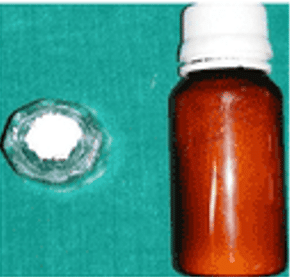
Figure 1: Graft material Medical Grade Calcium Sulphate Hemihydrate.
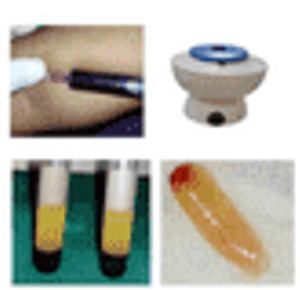
Figure 2: Preparation of PRF.
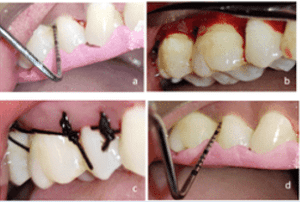
Figure 3: Group A: a -Stent with UNC 15 probe; b- Flap reflection and debridement; c- sutures placed; d- Six months postoperative.
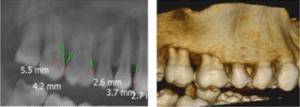
Figure 4: Group A – CBCT at baseline.
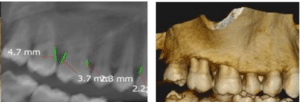
Figure 5: Group A- CBCT at six months postoperative.
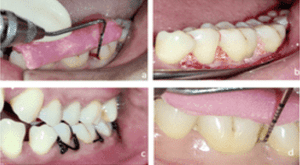
Figure 6: Group B a- Stent with UNC 15 probe; b- Graft placement after flap reflection and debridement; c- sutures placed; d- Six months postoperative.
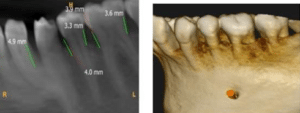
Figure 7: Group B- CBCT at baseline.
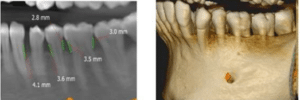
Figure 8: Group B- CBCT at six months postoperative.
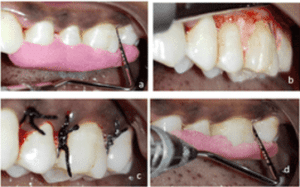
Figure 9: Group C a- Stent with UNC 15 probe; b- Placement of graft and PRF after flap reflection and debridement; c- sutures placed; d- Six months postoperative.

Figure 10: Group C CBCT at baseline.

Figure 11: Group C- CBCT at six months postoperative.
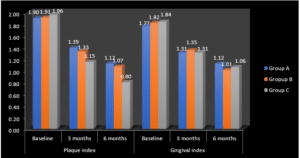
Figure 12: Clinical parameters between the group at different time interval (Intergroup).
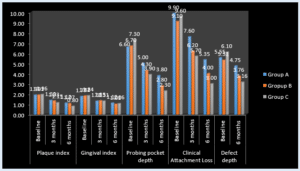
Figure 13: Clinical parameters at different time interval within each group (Intragroup).
Index | Time Period | Mean±SD Group A Group B Group C | Chi-square value | P-value | ||
Plaque Index | Baseline | 1.90±0.18 | 1.91±0.11 | 1.96±0.15 | 0.85 | 0.65 |
3 months | 1.39±0.12 | 1.33±0.12 | 1.15±0.24 | 6.31 | 0.04 | |
6 months | 1.12±0.11 | 1.07±0.16 | 0.80±0.11 | 16 | 0.001 | |
Gingival Index | Baseline | 1.77±0.22 | 1.82±0.21 | 1.84±0.15 | 0.47 | 0.71 |
3 months | 1.31±0.20 | 1.35±0.18 | 1.31±0.20 | 0.14 | 0.93 | |
6 months | 1.12±0.16 | 1.01±0.40 | 1.06±0.15 | 0.43 | 0.80 | |
Probing Pocket Depth | Baseline | 6.60±0.69 | 6.70±0.82 | 7.30±1.15 | 2.37 | 0.31 |
3 months | 5.00±0.66 | 4.30±0.94 | 3.90±0.97 | 7.04 | 0.034 | |
6 months | 3.80±0.78 | 2.80±0.78 | 2.30±0.48 | 13.65 | 0.001 | |
Clinical attachment loss | Baseline | 9.90±0.73 | 9.10±0.87 | 9.60±0.84 | 4.84 | 0.10 |
3 months | 7.60±0.96 | 6.20±0.82 | 5.70±0.67 | 14.91 | 0.001 | |
6 months | 5.35±0.33 | 4.00±0.40 | 3.00±0.40 | 25.43 | 0.001 | |
Defect depth | Baseline | 5.55±0.93 | 5.31±0.89 | 6.10±1.59 | 1.31 | 0.52 |
6 months | 4.75±0.94 | 3.76±0.99 | 3.16±1.47 | 8.44 | 0.015 | |
Table 1: Clinical parameters between the groups at different time interval (Intergroup).
Index | Groups | Mean±SD Baseline 3 Months 6 Months | P-value | ||
Plaque Index | Group A | 1.90±0.18 | 1.39±0.12 | 1.12±0.11 | 0.001 |
Group B | 1.91±0.11 | 1.33±0.12 | 1.07±0.16 | 0.001 | |
Group C | 1.96±0.15 | 1.15±0.24 | 0.80±0.11 | 0.001 | |
Gingival Index | Group A | 1.77±0.22 | 1.31±0.19 | 1.12±0.16 | 0.001 |
Group B | 1.82±0.20 | 1.35±0.18 | 1.01±0.40 | 0.001 | |
Group C | 1.84±0.15 | 1.31±0.19 | 1.06±0.15 | 0.001 | |
Probing Pocket Depth | Group A | 6.60±0.69 | 5.00±0.66 | 3.80±0.78 | 0.001 |
Group B | 6.70±0.82 | 4.30±0.94 | 2.80±0.78 | 0.001 | |
Group C | 7.30±1.15 | 3.90±0.97 | 2.30±0.48 | 0.001 | |
Clinical Attachment Loss | Group A | 9.90±0.73 | 7.60±0.96 | 5.35±0.33 | 0.001 |
Group B | 9.10±0.87 | 6.20±0.82 | 4.00±0.40 | 0.001 | |
Group C | 9.60±0.84 | 5.70±0.67 | 3.00±0.40 | 0.001 | |
Defect Length | Group A | 5.55±0.93 |
| 4.75±0.94 | 0.005 |
Group B | 5.31±0.89 |
| 3.76±0.99 | 0.005 | |
Group C | 6.10±1.59 |
| 3.16±1.47 | 0.005 | |
Table 2: Clinical parameters at different time interval within each group (Intragroup).


